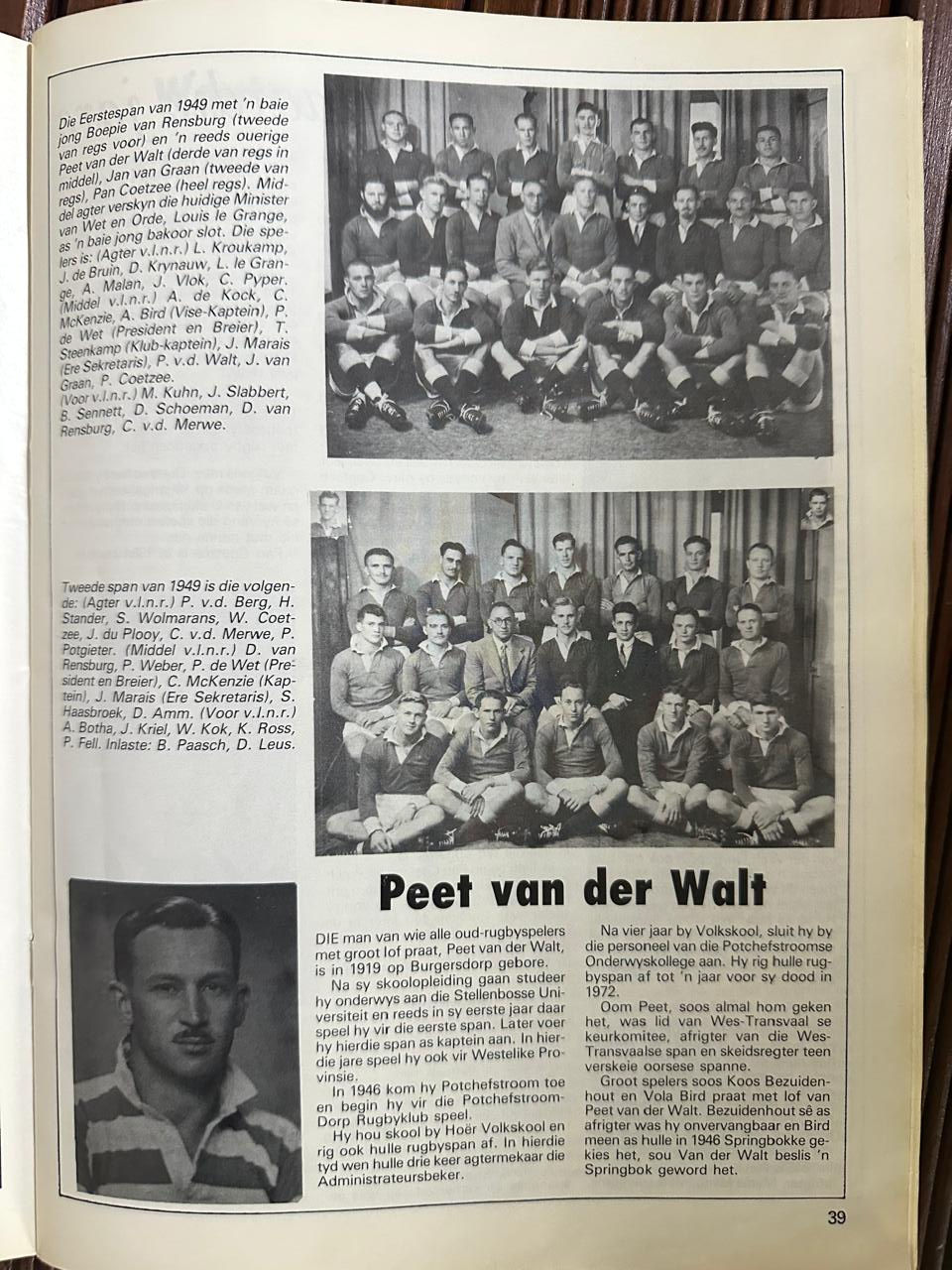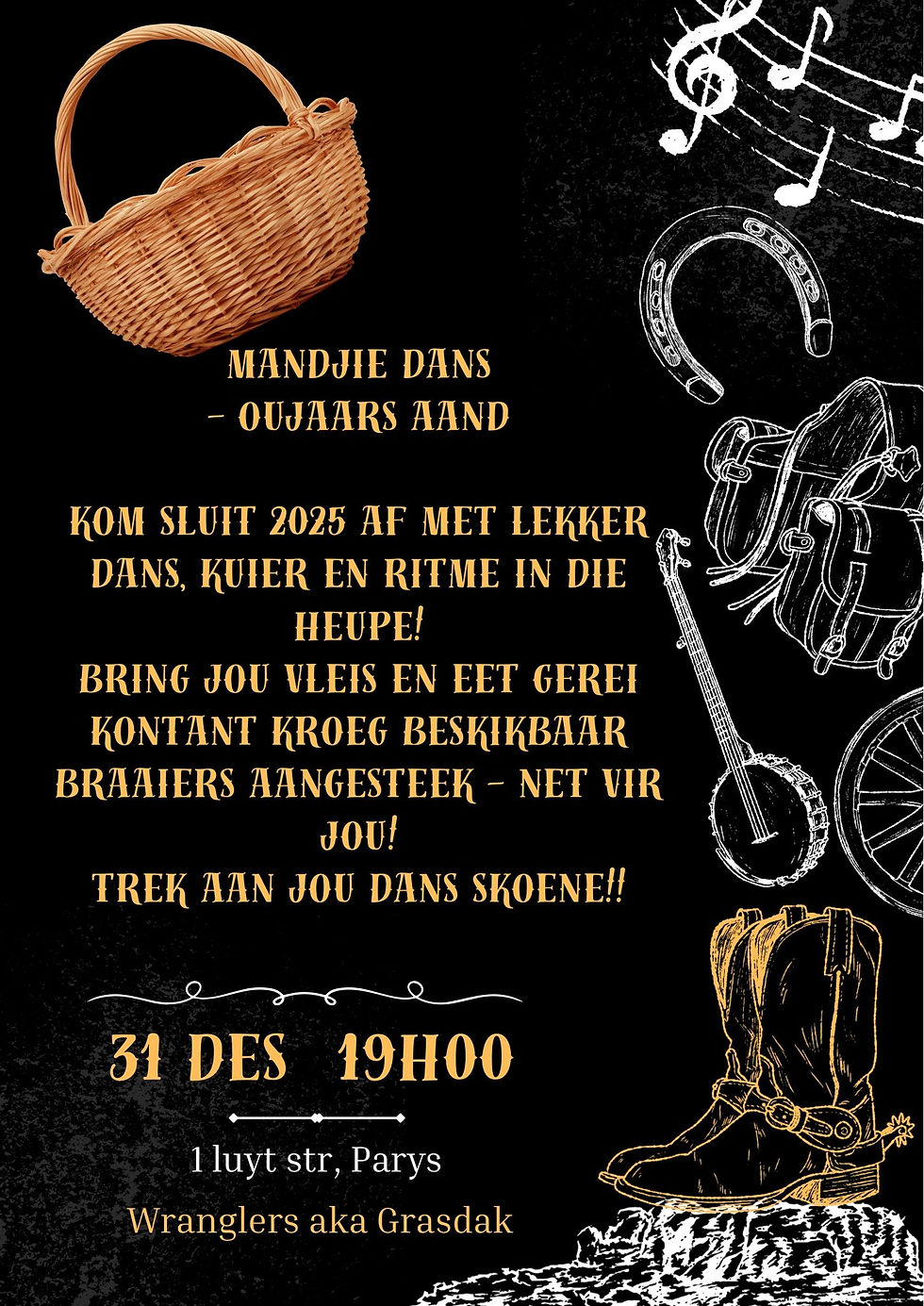History of Potchefstroom Dorp Rugbyklub: Rebuilding in the Late Forties
- Karen Scheepers

- May 21
- 7 min read

Picking Up the Pieces
The end of World War II brought with it a sense of collective relief, but also the daunting challenge of rebuilding. Across the world, towns and traditions had to be stitched back together and rugby was no different. For Potchefstroom Dorp Rugbyklub, the late 1940s became a period of regeneration, where pride returned to the pitch and new heroes rose to continue the legacy that had been paused by war. The club reclaimed its place in regional rugby dominance, with familiar names, fresh faces, and the iconic Blikbeker back on display.

1945–1946: Back to the Field, Back to the Blikbeker
In 1945, a revitalised Dorp side took to the field again. The squad that played in the Klerksdorp Beker final that year included standout players like J. Joubert, C. Coetzee, and G. Vlok, with coaching guidance and captaincy falling to rugby veteran Jan van Graan. This team symbolised a new beginning, a generation determined to restore Dorp's name in Western Transvaal rugby.
By 1946, they were back in the spotlight, lifting the Blikbeker once more. The winning team included P. Kotzé, F. Viljoen, R. Venter, and H. Scholtz, among others. The core of the team was made up of hardworking, gritty players like L.P. Roux, H. Swanepoel, C. Coetzee, and B. Burger. These names would go on to form the backbone of Dorp's success through the rest of the decade.

Respected Coach, Player, and Educator: Peet van der Walt's Lasting Legacy
The man spoken of with great admiration by all former rugby players, Peet van der Walt, was born in 1919 in Burgersdorp. After completing school, he studied education at Stellenbosch University and already in his first year, he played for the university’s first rugby team. Later, he moved to Potchefstroom where he played for the Potchefstroom-Dorp Rugby Club.
He began teaching at Hoër Volkskool and also started coaching the school’s rugby team. After four years at Volkskool, he joined the staff of the Potchefstroom Teachers' College. He coached their rugby team until a year before his death in 1972.
"Uncle Peet," as everyone knew him, was a member of the Western Transvaal selection committee, coach of the Western Transvaal team, and also served as a referee in matches against various overseas teams.
Great players like Koos Bezuidenhout and Vola Bird speak of Peet van der Walt with deep respect. Bezuidenhout says he was an irreplaceable coach, and Bird believes that had a Springbok team been selected in 1946, Van der Walt would certainly have made the cut.

Pan Coetzee, A Versatile Athlete and Rugby Icon Who Gave His All On and Off the Field
One could hardly find a more dynamic sportsman, there was hardly a sport Pan Coetzee did not master.
Born in 1911, Pan (P. J. J.) Coetzee began his rugby career at the Bellville Club in the Cape. Though he initially made his name as an athlete, he eventually shifted his focus to rugby, where his talent quickly became evident.
At the time, Coetzee and his family lived in Wynberg, and he had to take two trains just to get to Bellville for rugby practice, yet no sacrifice was too great for his passion. In December 1945, the Coetzee family relocated to Potchefstroom. By 1946, while still serving in the military, Coetzee joined the Potchefstroom-Dorp Rugby Club. That same year, he and his wife opened a sporting goods store for the Western Transvaal region. Two years later, he left the army to join his wife in running the store full-time.
Coetzee remained actively involved with both Potchefstroom-Dorp and the Western Transvaal Rugby Union until 1967. That year, when his wife became seriously ill, he made the decision to step away from all rugby activities to care for her.
During his career, Coetzee served as chairman of Potchefstroom-Dorp and was a member of the Western Transvaal selection committee. He later coached athletics at various schools across the region, sharing his knowledge and passion with countless young athletes.
In 1949, at the age of 38, Coetzee famously played against the All Blacks at Loftus Versfeld, a moment fondly remembered by many, including fellow rugby player Vola Bird. Bird recalled how, in a moment of desperation during a game, Coetzee, normally a front-row forward, attempted and successfully executed a drop kick between the posts.
Many have wondered where his nickname originated. Most believe it stemmed from his rugby-injured ear. However, according to Mrs. Coetzee, he earned the nickname at just 18 years old while playing cricket. He joked that he caught players with his ears, not his hands.
Pan Coetzee passed away in 1984, leaving behind a legacy of dedication, talent, and unforgettable stories on and off the field.
A. P. "Vola" Bird – A Lifelong Rugby Servant Who Played, Refereed, and Coached with Heart and Honour
A. P. BIRD (Vola) is a man who played 17 years for Potchefstroom-Dorp Rugby Club and, over a period of 16 years, for Western Transvaal. He arrived in Potchefstroom in 1945 to teach at Hoër Volkskool after completing his studies at Stellenbosch. That same year he began playing for Potchefstroom-Dorp and was also selected for the Western Transvaal team.
In June of that same year, Peet van der Walt (see p.39) also came from Stellenbosch to Potchefstroom. Vola Bird believes he was one of the greatest players he ever played alongside. He says that if a Springbok team had been selected in 1945, Peet van der Walt would certainly have become a Springbok. In those years, Van der Walt played fly-half and Bird centre.
Bird played centre, wing, and fly-half, but mostly as a wing. He remembers how they trained on the hard "Park B" with just a few blades of grass here and there. The locker rooms were made of corrugated iron, and the pavilion was a wooden structure. The entire field was surrounded by gum trees, and one advantage was that the wind never blew there. In 1945, Piet de Wet was the town team’s coach. Mynie Mynhardt was the secretary.
1946: Neser and Blaine Cups
In 1946, Potchefstroom-Dorp was a very strong team and won both the Neser and the Blaine Cups. Vola Bird remembers one incident from that year very clearly. They played in the final against Dominium Reefs when, after continuous foul play in the lineouts, the referee sent one of Dominium Reefs’ players off the field. The entire team then walked off, and they were suspended for seven years, which once again shows how strictly rules were enforced at the time.
According to Bird, rugby coaching in those years was quite primitive and did not use any of the modern techniques we know today. The main goal was to get fit, and every training session felt like a match. Each player also had to pay for his own jersey, transport, and medical care. There was no mention of insurance or funding. Still, they sacrificed everything for rugby. The team spirit and camaraderie were unbeatable, and the players gave their all to attend training.
Later Career
Vola Bird played many years for Potchefstroom-Dorp. He was also a referee and coached school rugby. In 1959, Hoër Volkskool, under his leadership, won the Administrators' Cup.
Some of the great names who played alongside him, many of whom have since passed away, include:Chris Briers, Jan van Graan, Chris Jooste, G. C. O. Latagan, and Simon Bezuidenhout.

Wouter de Vos, A Humble Leader Who Honoured Tradition and Served Rugby with Integrity
Wouter, player for the Potchefstroom-Dorp Rugby Club, captain, and later president of the Stellenbosch club, writes:
“It was a privilege for me to play for Potchefstroom-Dorp from 1950 to 1953.I took over the captaincy in 1951 from Pan Coetzee and held it until the end of 1953 when I left. In 1954, Johan Claassen took over from me as captain, also as a representative of Western Transvaal.
The approach at Potchefstroom-Dorp was conservative and principled. Traditions were upheld. When I joined the club in July 1950, I was already captain of Western Transvaal and had also played against Eastern Transvaal and Transvaal. I had already completed a tour with the Springbok team in 1949.
Yet, for my first match for Potchefstroom-Dorp, I had to play for the second team. It was against Blyvooruitsig on their field. Three selectors from Potchefstroom-Dorp, Pan Coetzee, Piet de Wet, and Jan Marais, were present. Would that still happen today? I wonder. I still talk about it wherever I go. I will always remember it.”
Louis le Grange – From Rugby Field to Parliament, a Loyal Supporter of Potch-Dorp Through the Years
Former player, Minister of Law and Order at the time, and patron of the Western Transvaal Rugby Union, wrote the following Letter:
“Thank you very much for the latest newsletter I received. It is truly a privilege to share in all of Dorp’s activities through your updates. It is indeed true that Dorp is one of the top club teams and supporter organizations in the country. Uncle Piet de Wet and Pan Coetzee were two of the most well-known figures in that regard. I see that you plan to publish statistics about Dorp’s success in the Neser Cup, and in that context I cannot help but fondly remember one Wednesday evening in September 1954 when Dorp lost approximately 26–3 in a friendly match against POK , shortly after Johan Pienaar, then Western Transvaal centre and Springbok trial player, coached the pre-season and led the team for that year. That year, Dorp didn’t lose a single Neser Cup match and defeated most of their Blaine Cup opponents on Saturdays and Goldfields midweek. It was one of those seasons where everything went right and the team outperformed all expectations. You also asked me to say something about the general spirit and club culture of those years. I remember with pride how every player wore the team name with honour. If you were far ahead in the score, you gave the other team a chance. They needed encouragement, and you understood that. I wish you and all your collaborators the very best with the special task you are busy with.”
The Rebuilders and the Visionaries
The post-war period of the late 1940s and into the early 1950s was a golden age of transformation. The players rebuilt the game. The coaches rebuilt the teams. And the visionaries, like Bird, Coetzee, le Grange, and de Vos, built a culture that would carry Potchefstroom Dorp Rugbyklub into its most celebrated decades.
This was more than a recovery. It was a renaissance. The players returned from war with scars, but also with purpose. The supporters came back to the fields with renewed energy. And the club marched forward, Blikbeker in hand, community in heart.









Comments